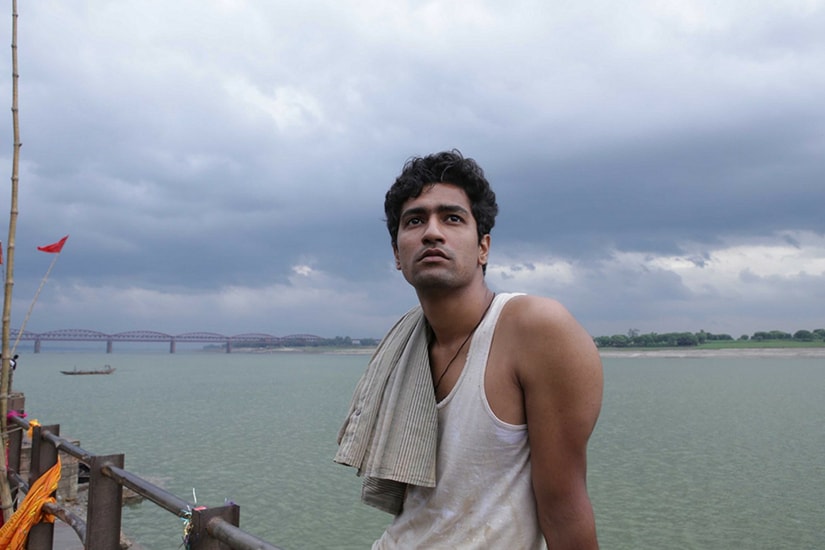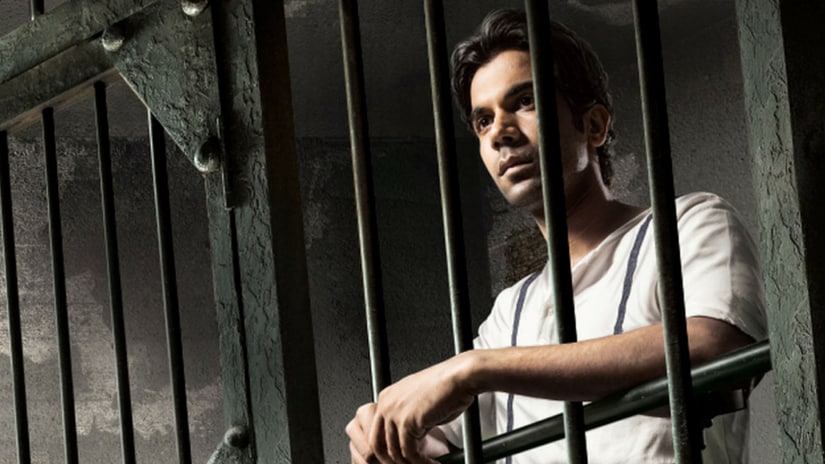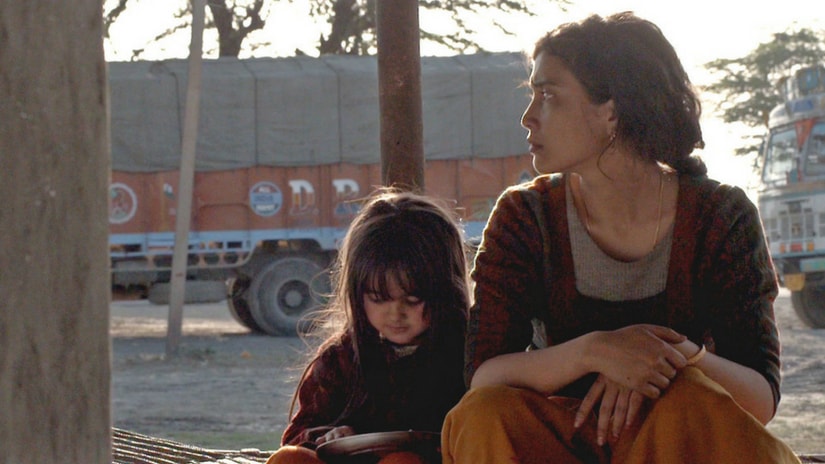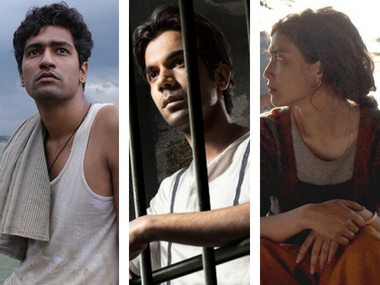For Hindi cinema, these are genuinely interesting times.
Sanju
, well on its way to make
300 crores
and a blockbuster that qualifies as entertaining, good cinema, features young Vicky Kaushal as second lead. Like Ranbir Kapoor, whom critics and audiences have applauded, Kaushal’s sparkling performance has won equal measure of praise and accolades. With Rajkumar Hirani’s entertaining ‘biopic’ and the faith the filmmaker has placed in him, Vicky Kaushal’s potential as a future star of mainstream Hindi film is now heightened. Vicky Kaushal is an interesting example of the change that has come, and, hopefully, is here to stay. Having debuted in
Masaan
, the young actor doesn’t fit in the mode of conventional good looks as defined by Bollywood. Yet, right from his first film, Kaushal’s merit as a performer shone through. We owe a debt to alternate voices in Hindi cinema for trusting him with the part of leading man in Masaan,
Zubaan
and
Raman Raghav 2.0
. Phantom Films and Anurag Kashyap are integral in spotting Kaushal and Nawazuddin Siddiqui as leading man material. Kaushal delivered a frothy, fun and credible performance in the Netflix original
Love Per Square Foot
, and then Sanju happened. His unusual looks don’t matter given his screen presence and natural confidence. His acceptance reflects that audiences have driven from the bottom up; and that some filmmakers and producers have faith in him indicates that ‘hero looks’—that non-inclusive criterion that has often been practiced in Hindi cinema—might no longer be a deciding factor in defining a leading man. [caption id=“attachment_4735791” align=“alignnone” width=“825”]
 Vicky Kaushal in Masaan/Image from Twitter.[/caption] Vicky Kaushal is not the only actor whose looks don’t become a limitation in Hindi film. There’s Rajkummar Rao whose sheer acting merit stands out ahead of everyone else. Kaushal had landed his break as leading man in Masaan because Rao’s dates didn’t work out. Having made a start in roles that showed his versatility, Rao now has
Ek Ladki Ko Dekha To Aisa Laga
,
Fanney Khan
and
Mental Hai Kya
. He is part of mainstream Hindi films, both as leading man and as pivotal character. Having made an impact with his earlier films, including Shahid, this alternate cinema hero has transcended to the mainstream because stories that require strong performers rather than ‘heroes’ are gradually gaining ground in Hindi cinema. One can spot a similar trend in the success of Ayushmann Khurrana and Bhumi Pednekar. Neither are good looking in the Hindi film hero and heroine sense; but both have delivered super hits, playing author backed characters as leads. Audiences have accepted them without question. About fifteen years ago, Rajkummar Rao, Vicky Kaushal and Ayushmann Khurrana might not have made it to the hero cut in Hindi films. The graph of prejudice against those that don’t fit in the conventional good looks mode is consistent. A good example is Anupam Kher—despite his brilliance as a performer, he made his debut as an ageing father in Saaransh in 1984. Kher never played leading man till the 2000s, relegated to playing silly, goofy uncle parts or comic book villain. American TV and Hollywood often picking him for important character roles reflects his talent and appeal as performer. But this wasn’t enough to convince Hindi filmmakers to entrust him with hero roles. The late Om Puri is another example of a performer par excellence that didn’t become a mainstream Hindi film hero ever. Someone as talented as Irrfan Khan, second to none as actor, has had to wait for over 15 years and play character parts in Hindi films before landing a hero role in
Paan Singh Tomar
and
Hindi Medium
. [caption id=“attachment_4735871” align=“alignnone” width=“825”]
Vicky Kaushal in Masaan/Image from Twitter.[/caption] Vicky Kaushal is not the only actor whose looks don’t become a limitation in Hindi film. There’s Rajkummar Rao whose sheer acting merit stands out ahead of everyone else. Kaushal had landed his break as leading man in Masaan because Rao’s dates didn’t work out. Having made a start in roles that showed his versatility, Rao now has
Ek Ladki Ko Dekha To Aisa Laga
,
Fanney Khan
and
Mental Hai Kya
. He is part of mainstream Hindi films, both as leading man and as pivotal character. Having made an impact with his earlier films, including Shahid, this alternate cinema hero has transcended to the mainstream because stories that require strong performers rather than ‘heroes’ are gradually gaining ground in Hindi cinema. One can spot a similar trend in the success of Ayushmann Khurrana and Bhumi Pednekar. Neither are good looking in the Hindi film hero and heroine sense; but both have delivered super hits, playing author backed characters as leads. Audiences have accepted them without question. About fifteen years ago, Rajkummar Rao, Vicky Kaushal and Ayushmann Khurrana might not have made it to the hero cut in Hindi films. The graph of prejudice against those that don’t fit in the conventional good looks mode is consistent. A good example is Anupam Kher—despite his brilliance as a performer, he made his debut as an ageing father in Saaransh in 1984. Kher never played leading man till the 2000s, relegated to playing silly, goofy uncle parts or comic book villain. American TV and Hollywood often picking him for important character roles reflects his talent and appeal as performer. But this wasn’t enough to convince Hindi filmmakers to entrust him with hero roles. The late Om Puri is another example of a performer par excellence that didn’t become a mainstream Hindi film hero ever. Someone as talented as Irrfan Khan, second to none as actor, has had to wait for over 15 years and play character parts in Hindi films before landing a hero role in
Paan Singh Tomar
and
Hindi Medium
. [caption id=“attachment_4735871” align=“alignnone” width=“825”]
 Rajkummar Rao in Shahid/image from Twitter.[/caption] There are more such examples of looks becoming a filter to not cast a talented performers as hero or heroine. In the late eighties and nineties, creatively hit a plateau phase for Hindi cinema that continued well into the early 2000s. Typical heroes and heroines continued to dance, prance, romance and fight bad buys in the same script. This phase pretty much rang the death knell for true blue acting talent, save a few exceptions. Ajay Devgn’s success brought in a change. As he has often stated, in the initial phase of his career, not many entrusted him with the hero role as he didn’t look the part. The hero was defined by some specifications like a sharp nose, sharp features, fair or wheatish complexion, tousled hair and dominantly heartland or Punjabi features. Devgn didn’t fit in with his dusky complexion and common man looks. But a potentially powerhouse performer and deft at action, he survived, growing from strength to strength. With films like Zakhm, Company and Gangajal, the actor in him flourished. In more ways than one, he changed the game. That the typical Hindi film is no longer a safe bet is reflected from this year’s hits. Sanju,
Veere Di Wedding
,
Sonu Ki Titu Ki Sweety
is not close to the norm of a typical film. For every
Race 3
and
Baaghi 2
, refreshingly, there’s a
Raazi
and
Raid
this year. A trend that had emerged in 2016 and 2017 is established now. Audiences dictate who or what is worth it and what isn’t. [caption id=“attachment_4735911” align=“alignnone” width=“825”]
Rajkummar Rao in Shahid/image from Twitter.[/caption] There are more such examples of looks becoming a filter to not cast a talented performers as hero or heroine. In the late eighties and nineties, creatively hit a plateau phase for Hindi cinema that continued well into the early 2000s. Typical heroes and heroines continued to dance, prance, romance and fight bad buys in the same script. This phase pretty much rang the death knell for true blue acting talent, save a few exceptions. Ajay Devgn’s success brought in a change. As he has often stated, in the initial phase of his career, not many entrusted him with the hero role as he didn’t look the part. The hero was defined by some specifications like a sharp nose, sharp features, fair or wheatish complexion, tousled hair and dominantly heartland or Punjabi features. Devgn didn’t fit in with his dusky complexion and common man looks. But a potentially powerhouse performer and deft at action, he survived, growing from strength to strength. With films like Zakhm, Company and Gangajal, the actor in him flourished. In more ways than one, he changed the game. That the typical Hindi film is no longer a safe bet is reflected from this year’s hits. Sanju,
Veere Di Wedding
,
Sonu Ki Titu Ki Sweety
is not close to the norm of a typical film. For every
Race 3
and
Baaghi 2
, refreshingly, there’s a
Raazi
and
Raid
this year. A trend that had emerged in 2016 and 2017 is established now. Audiences dictate who or what is worth it and what isn’t. [caption id=“attachment_4735911” align=“alignnone” width=“825”]
 Geetanjali Thapa in Liar’s Dance/Image from Twitter.[/caption] The change is yet to happen for leading women. Geetanjali Thapa, the talented actor that won a National Film Award for Liar’s Dice, is more visible now in films like
Bioscopewala
and
Sacred Games
. Thapa has remarked on the prejudice she has faced. Her northeastern features marked her out as someone who doesn’t quite look ‘Indian’. Exclusion of this kind would remove a chunk of India’s performing talent; especially from a region that has given performers like Seema Biswas and Adil Hussain. Once audiences begin to watch heroines that don’t look like the lissome, svelte, straight haired norm, then a shift in who is a Hindi film hero or heroine will become permanent. The onus of driving change lies with them. Once they pick those that can relate to as the people they want to see onscreen, an illogical bias towards hero or heroine looks will slowly fade out.
Geetanjali Thapa in Liar’s Dance/Image from Twitter.[/caption] The change is yet to happen for leading women. Geetanjali Thapa, the talented actor that won a National Film Award for Liar’s Dice, is more visible now in films like
Bioscopewala
and
Sacred Games
. Thapa has remarked on the prejudice she has faced. Her northeastern features marked her out as someone who doesn’t quite look ‘Indian’. Exclusion of this kind would remove a chunk of India’s performing talent; especially from a region that has given performers like Seema Biswas and Adil Hussain. Once audiences begin to watch heroines that don’t look like the lissome, svelte, straight haired norm, then a shift in who is a Hindi film hero or heroine will become permanent. The onus of driving change lies with them. Once they pick those that can relate to as the people they want to see onscreen, an illogical bias towards hero or heroine looks will slowly fade out.
How Vicky Kaushal, Rajkummar Rao, Geetanjali Thapa are upending Bollywood's preference for conventional good looks
Archita Kashyap
• July 14, 2018, 13:51:44 IST
From Vicky Kaushal in Masaan, Rajkummar Rao in Shahid and Geetanjali Thapa in Liar’s Dice, how actors are changing people’s understanding of a typical hero.
Advertisement
)
End of Article